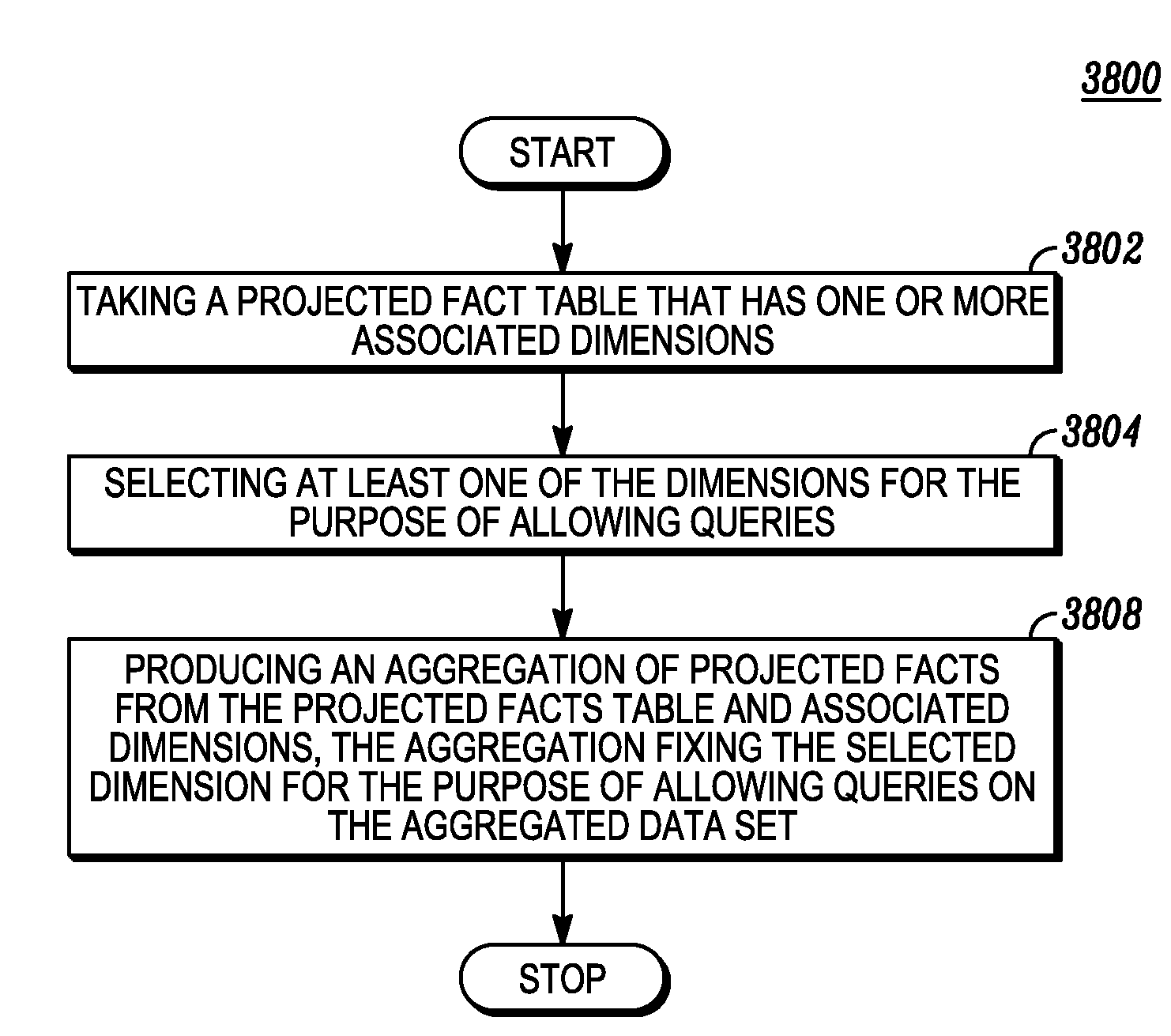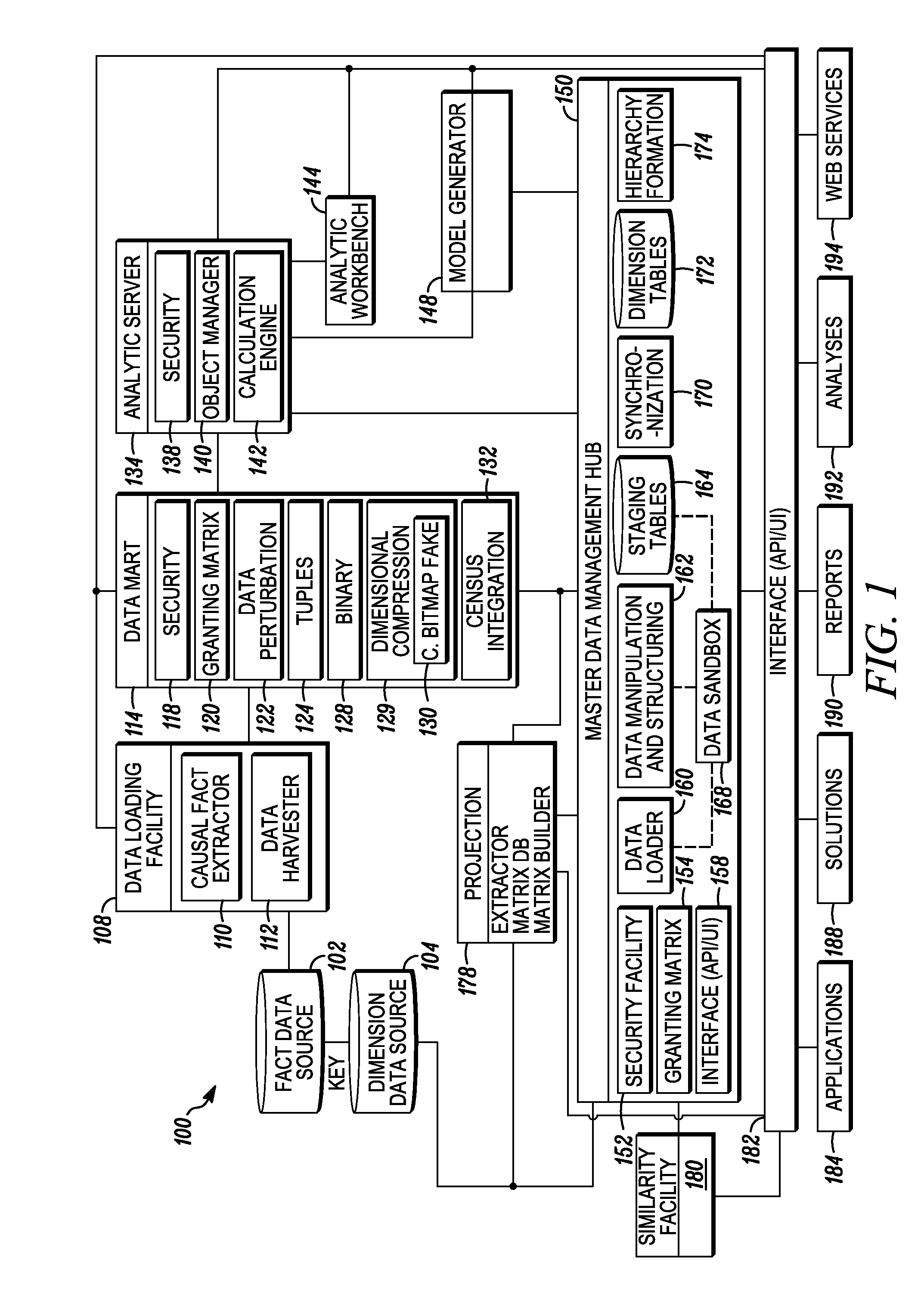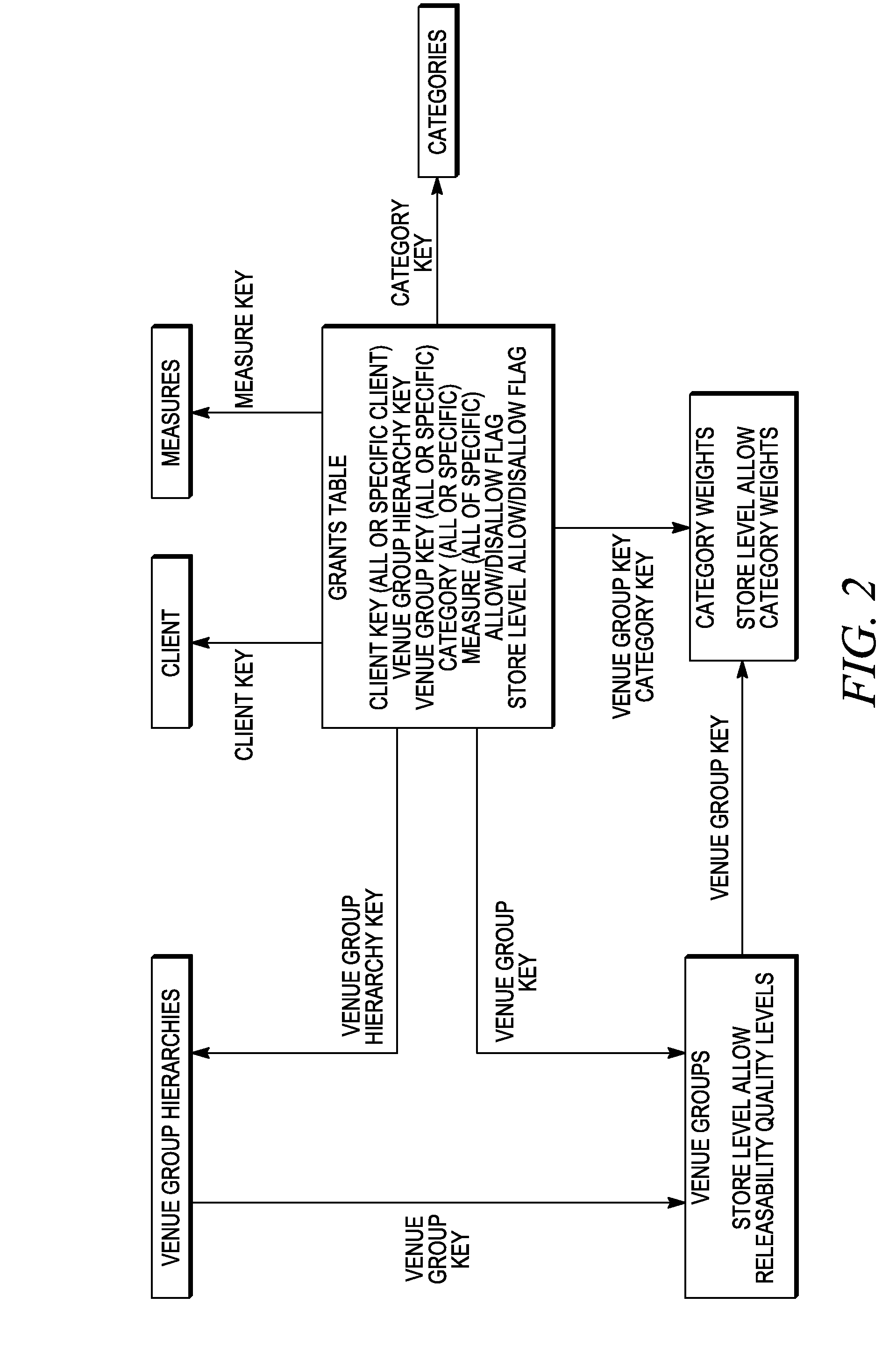[0413]It will be appreciated that this projection query could take a long time to process if the venue group involved is large (i.e., contains a lot of stores) and / or a long period of time is desired. An
advantage of the present invention is provided through the pre-aggregation of sales data and projection weights into a projected facts table (not to be confused with the projection
fact table). The projected facts table (projectedfact) contains projected facts stored keyed by time, item, and venue group. The projected facts table may contain projected sales (projectedfact.projectedsales) that result from aggregating projection.weight times sales facts.sales grouped by time, item, and venue group. Having calculated the projected facts table, it is possible to produce projected sales aggregations according to the following query:
[0414]As compared with the first example query, it will be appreciated that flexibility remains in the item_dim dimension while the number of fact tables is reduced to one. In addition, it will be appreciated that, due to the projected facts being aggregated on venue groups, facts that were originally represented by venue are compressed down into aggregated facts that correspond to venue groups. In embodiments, the number of venues in a group can exceed 1,000, so this compression can provide a significant (in this example, perhaps a 1000:1 or greater) reduction in the time required to produce projected sales aggregations. Similarly, the projected facts table may store projected sales that are aggregated by time period, which could still further reduce the time required to produce projected sales aggregations. In all, these improvements may accommodate the user 130 by reducing the time required to generate projected sales aggregations while providing flexibility with respect to at least one dimension. This reduction in the time required may be so significant that it allows the user 130 to interactively select a point along the flexible dimension and see the resulting projected sales aggregations in or near real time.
[0415]The binary 128 may comprise a
bitmap index into a
fact table, which may be generated by a
bitmap generation facility. Domains of the index may be selected from the
fact table so as to allow flexibility along a specific dimension of an aggregation. The binary 128 or
bitmap index may be generated in response to a
user input, such as and without limitation a specification of which dimension or dimensions should be flexible. Alternatively or additionally, the binary 128 may be generated in advance, such as and without limitation according to a default value. The binary 128 may be embodied as a binary and / or or may be provided by a
database management system, relational or otherwise.
[0416]The following example is provided for the purposes of illustration and not limitation. One or more fact tables 104 encompassing an item domain, a
time domain, a venue domain, and a venue group domain may be provided. Facts within these fact tables, which may be embodied as rows of the tables, may relate to actual and / or projected sales, wherein a sale may be encoded as a time of sale, an item sold, and the venue and / or venue group associated with the sale. The aggregation produced from the one or more fact tables may comprise a sales dimension, an item dimension, and a venue group dimension aggregated at the regional level. A user may specify (such as via the
user input) that he is interested in the percentage of total sales that are attributed to a particular venue. Perhaps in response to this specification and / or perhaps in accordance with the default value, the bitmap generation facility may create a binary 128 containing a reference for each value in the venue and item domains of the one or more fact tables; any and all of the references may comprise an entry, vector, pointer, or the like. In other words, each of the references in the binary 128 may
encode the location of the facts that correspond to each venue and each item. Given these locations, the total sales for a particular venue may be calculated: the location of all the facts that are associated with the venue are encoded in the index; a query
processing facility may utilize the
bitmap index to rapidly locate the facts that correspond to the venue. Since each fact may correspond to an item sold, the query
processing facility may count the facts that it located to determine the number of items sold. Meanwhile, the total sales for all stores may be calculated by summing all of the sales values of all of the items in all of the venue groups of the aggregation. The ratio of total sales for the venue to total sales for all venue groups, which may be the analytical result, may be the percentage of total sales in which the user expressed interest. It will be appreciated that, in embodiments, it may not be possible to produce the analytical result for the user by simply counting the facts located via the index. In such cases, any and all of those facts may be accessed and one or more values of those facts may be summed, aggregated, or otherwise processed to produce the analytic result. In any case, it will be appreciated by those skilled in the art that the binary 128 may provide dramatic improvements in
system performance of the query
processing facility when it is producing an analytical result, such as and without limitation a percentage of total sales that are attributed to a particular venue and so forth.
[0417]The facts may be embodied as tuples or rows in a fact table and may comprise numbers, strings, dates, binary values, keys, and the like. In embodiments but without limitation, the facts may relate to sales. The facts may originate from the source fact table and / or the projection fact table. The source fact table may in whole or in part be produced by a fact-producing facility. The projection fact table may in whole or in part be produced by a projection facility (such as and without limitation the projection facility 178). In embodiments, the fact-producing facility may without limitation encompass a point-of-sale facility, such as a cash register, a magnetic stripe reader, a
laser barcode scanner, an RFID reader, and so forth. In embodiments the projection facility may without limitation consist of computing facility capable of generating part or all of the projection fact table, which may correspond to projected sales. In embodiments, the bitmap generation facility may index the facts, producing the binary 128. The query processing facility may utilize the
bitmap index when processing certain queries so that as to provide
improved performance, as perceived by the user, without utilizing an auxiliary aggregation. In embodiments, there may or may not be at least one reference in the binary 128 for any and all of the facts. In embodiments, there may be indexes and / or references for aggregated, pre-aggregated, and / or non-aggregated facts. In embodiments, the index may be embodied as a
bitmap index.
[0418]In embodiments, the query processing facility may use the fact table, the aggregation, and / or and the index to provide a user-defined
data projection, which may be the analytical result. In an embodiment, the fact table may provide input to the projection facility, which may or may not utilize that input to produce the projection fact table. In an embodiment, the query processing facility may process the facts by pre-aggregating them in a predefined manner, for example and without limitation as may be defined by the
user input or the default value. In embodiments, the predefined manner may include not pre-aggregating at least one domain of the fact table (wherein the one domain may or may not be used in a later query); generating an index that is directed at providing flexibility at query time with respect to at least one dimension of the pre-aggregation (whether or not one or more domains of the fact table have been pre-aggregated); and so forth. In embodiments, a user, a default value, a projection provider (which may be an entity that employs the present invention), a value associated with a market, or the like may define at least one domain and / or at least one dimension. This domain and / or this dimension may be the same for all of a plurality of users; may be different for some or all of the plurality of users; may be associated with a particular projection fact table and / or fact table; and so on. In an embodiment, the query processing facility may provide an output to an
end user. The output may comprise or be associated with the user-defined
data projection (i.e., the analytical result). The analytical result may be a value, table,
database,
relational database, flat file, document, data cube, data
hypercube, or the like. In an embodiment, a user may submit a query in response to the analytical result and / or the analytical result may be a result that is produced by the query processing facility in response a query that is associated with the user.
 Login to View More
Login to View More  Login to View More
Login to View More 


